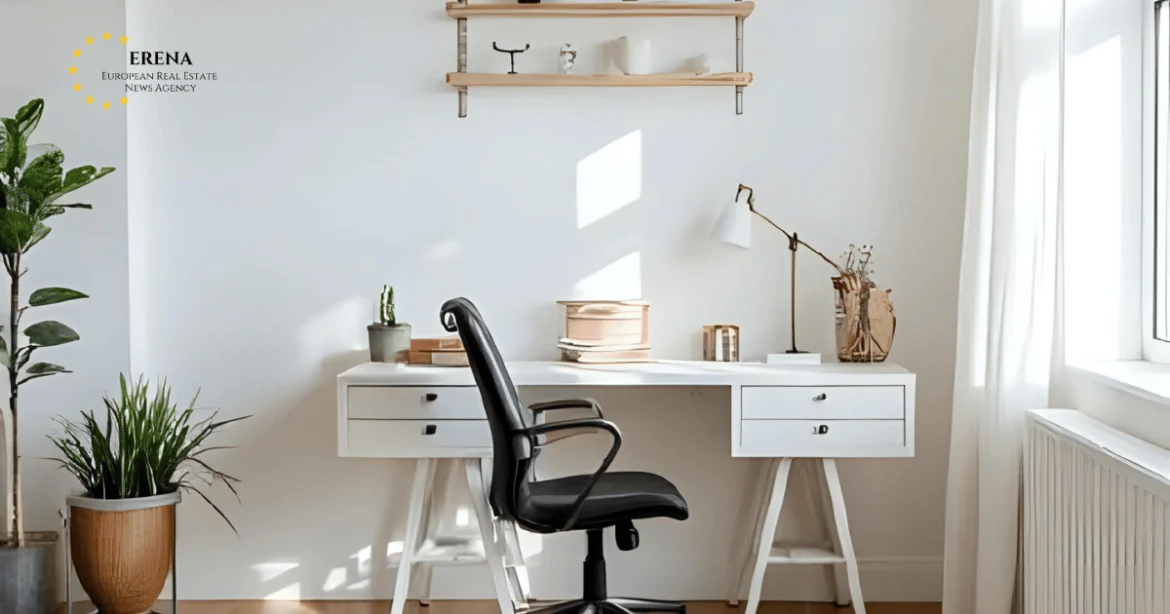When remote work exploded in 2020, people around the world scrambled to adapt. Kitchen tables became temporary offices, laptops perched on ironing boards stood in for standing desks, and video calls revealed how unprepared most homes were for professional work. What was meant as a short-term compromise slowly evolved. By 2025, hybrid work has settled into a rhythm, and the home office—no longer a novelty—is now a permanent feature of urban apartments. But in cities like Paris, Milan, and Berlin, where space is scarce, the challenge is clear: how to carve out a professional workspace in flats barely larger than 25–30 m².
From Improvised to Intentional
In the early months of the pandemic, surveys showed that more than half of Europeans worked from their kitchen or living room table. Chairs were often wooden, lighting came from ceiling lamps, and ergonomics were almost entirely forgotten. Within a year, however, back pain, fatigue, and “Zoom exhaustion” drove a surge in demand for better setups. Retailers reported double-digit growth in desk and office chair sales, while tech brands rushed to promote external monitors and webcams.
Fast forward to 2025, and the change is striking. The home office is no longer improvised—it is designed. The “one-wall office” has become the dominant model: a narrow desk, a compact chair, and a monitor positioned in a corner or along one wall. What began as survival has turned into lifestyle.
Furniture Built for Micro-Apartments
Furniture brands have adapted quickly. IKEA’s LAGKAPTEN/ALEX desk combination, priced at €80–€100 depending on the market, became a bestseller because it fits into a metre-wide alcove. The NORBERG wall-mounted desk (around €29 in Spain) has become a classic for studios, folding neatly away after hours. In Berlin and Milan, architects report a rise in custom joinery—wardrobes with built-in worktops or bookshelves that conceal hidden desks.
This shift is cultural as much as practical. In 2020, many felt guilty about letting work “invade” the home. By 2025, the idea of dedicating part of the living room wall to a permanent workstation feels natural.
Ergonomics Enters the Conversation
If the early years were about “making do,” the new era is about health. Dining chairs have been replaced by compact ergonomic models. The LÅNGFJÄLL (€169–€189) and MARKUS (€139–€189) have become staples in Europe’s small flats, while the JÄRVFJÄLLET (€299) is seen as a long-term investment.
Medical associations and physiotherapists across Europe warn that even in apartments of 25 m², posture cannot be left to chance. The lessons from lockdown—back pain, repetitive strain, and fatigue—have left a lasting mark, turning ergonomics into a central part of home-office design.
Technology That Streamlines
In 2020, most workers relied on laptops alone. Today, technology has caught up with the needs of small apartments. USB-C monitors have been a game-changer, reducing clutter to a single cable. The iiyama XUB2497HSN (€181) and AOC 24P3CV (€257.85) not only extend screen space but also power laptops and connect peripherals.
At IFA Berlin 2025, brands showcased compact monitors with KVM switches—allowing one keyboard and mouse to control multiple laptops. For freelancers juggling corporate and personal machines, this solves a problem that frustrated workers back in 2020.
Light, Noise, and Atmosphere
Another overlooked factor in 2020 was environment. Workers often sat in dim rooms or in noisy flats with thin walls. By 2025, awareness has grown. European standard EN 12464-1 recommends 500 lux at desk level, which has become a common benchmark. Slim task lamps like IKEA’s HÅRTE LED (€15) or BenQ’s ScreenBar (€99–€149) are now household essentials.
Noise remains a challenge in dense cities, but workers have found solutions. Rugs, curtains, and door sweeps help, but the most popular tool has been noise-cancelling headphones. The Sony WH-1000XM5, at €359.99, sells as much for home offices as for travel.
What It Costs Then and Now
In 2020, most workers spent little or nothing on their home setups, repurposing what they already had. By 2025, budgets have stabilised:
- Starter setups (~€340) cover a narrow desk, simple chair, and 24-inch monitor.
- Mid-range setups (€650–€750) include a sturdier chair, better monitor, and lighting.
- Premium compact offices (€1,200+) feature sit-stand desks like the FlexiSpot E7 Pro (€349.99 plus tabletop) and ergonomic chairs that rival corporate offices.
The willingness to invest reflects the permanence of hybrid work. What once felt temporary now justifies long-term spending.
The New Normal of Work-at-Home
The story of the home office is one of transformation. In 2020, it was a kitchen table with a laptop. By 2025, it is a carefully designed corner with ergonomic furniture, integrated lighting, and streamlined technology. More importantly, it is no longer seen as a compromise but as an expected feature of modern apartments.
In an age when cities are denser, flats are smaller, and hybrid work is here to stay, the compact home office has become a cultural marker of how society adapts. It is not about space—it is about design. And in that sense, the smallest apartments often reveal the smartest solutions.

